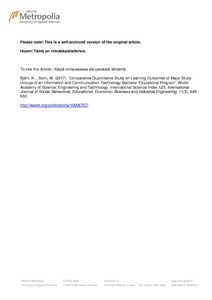Comparative quantitative study on learning outcomes of major study groups of an information and communication technology bachelor educational program
Björn, Kari; Soini, Mikael (2017)
Björn, Kari
Soini, Mikael
World Academy of Science, Engineering and Technology
2017
Julkaisun pysyvä osoite on
https://urn.fi/URN:NBN:fi:amk-201705168388
https://urn.fi/URN:NBN:fi:amk-201705168388
Tiivistelmä
Higher Education system reforms, especially Finnish system of Universities of Applied Sciences in 2014 are discussed. The new steering model is based on major legislative changes, output-oriented funding and open information. The governmental steering reform, especially the financial model and the resulting institutional level responses, such as a curriculum reforms are discussed, focusing especially in engineering programs. The paper is motivated by management need to establish objective steering-related performance indicators and to apply them consistently across all educational programs. The close relationship to governmental steering and funding model imply that internally derived indicators can be directly applied. Metropolia University of Applied Sciences (MUAS) as a case institution is briefly introduced, focusing on engineering education in Information and Communications Technology (ICT), and its related programs. The reform forced consolidation of previously separate smaller programs into fewer units of student application. New curriculum ICT students have a common first year before they apply for a Major. A framework of parallel and longitudinal comparisons is introduced and used across Majors in two campuses. The new externally introduced performance criteria are applied internally on ICT Majors using data ex-ante and ex-post of program merger. A comparative performance of the Majors after completion of joint first year is established, focusing on previously omitted Majors for completeness of analysis. Some new research questions resulting from transfer of Majors between campuses and quota setting are discussed. Practical orientation identifies best practices to share or targets needing most attention for improvement. This level of analysis is directly applicable at student group and teaching team level, where corrective actions are possible, when identified. The analysis is quantitative and the nature of the corrective actions are not discussed. Causal relationships and factor analysis are omitted, because campuses, their staff and various pedagogical implementation details contain still too many undetermined factors for our limited data. Such qualitative analysis is left for further research. Further study must, however, be guided by the relevance of the observations.
